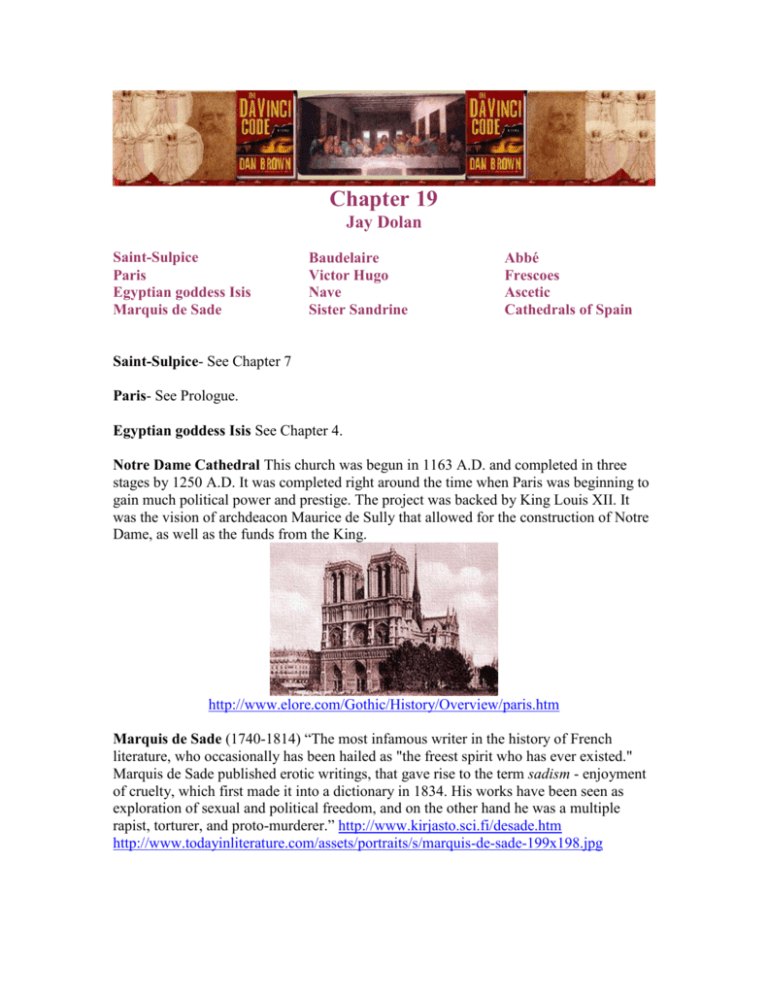
Chapter 19
Jay Dolan
Saint-Sulpice
Paris
Egyptian goddess Isis
Marquis de Sade
Baudelaire
Victor Hugo
Nave
Sister Sandrine
Abbé
Frescoes
Ascetic
Cathedrals of Spain
Saint-Sulpice- See Chapter 7
Paris- See Prologue.
Egyptian goddess Isis See Chapter 4.
Notre Dame Cathedral This church was begun in 1163 A.D. and completed in three
stages by 1250 A.D. It was completed right around the time when Paris was beginning to
gain much political power and prestige. The project was backed by King Louis XII. It
was the vision of archdeacon Maurice de Sully that allowed for the construction of Notre
Dame, as well as the funds from the King.
http://www.elore.com/Gothic/History/Overview/paris.htm
Marquis de Sade (1740-1814) “The most infamous writer in the history of French
literature, who occasionally has been hailed as "the freest spirit who has ever existed."
Marquis de Sade published erotic writings, that gave rise to the term sadism - enjoyment
of cruelty, which first made it into a dictionary in 1834. His works have been seen as
exploration of sexual and political freedom, and on the other hand he was a multiple
rapist, torturer, and proto-murderer.” http://www.kirjasto.sci.fi/desade.htm
http://www.todayinliterature.com/assets/portraits/s/marquis-de-sade-199x198.jpg
Baudelaire- (1821-1867) “Charles Baudelaire was a 19th century French poet, translator,
and literary and art critic whose reputation rests primarily on ‘Les Fleurs du mal’ which
was perhaps the most important and influential poetry collection published in Europe in
the 19th century.” http://www.empirezine.com/spotlight/bau/bau-bio.htm
http://www.stellaweb.ch/maitres/nadar/baudelaire.jpg
Victor Hugo (1802-1885) He was a novelist, poet, and dramatist. During the 19th century
he was one of France’s most important Romantic writers. Hugo wrote The Hunchback of
Notre Dame and Les Miserables.
http://www.kirjasto.sci.fi/vhugo.htm
http://www.lesmis.de/images/hugo.jpg
Nave “The main part or body of a church, extending from the inner door to the choir or
chancel, and usually separated from the aisle on each side by pillars.”
http://dictionary.oed.com/cgi/entry/00156022?query_type=word&queryword=Nave&edit
ion=2e&first=1&max_to_show=10&sort_type=alpha&result_place=2&search_id=ifbuTzKktk-1815&hilite=00156022
Sister Sandrine See Chapter 7
Abbé “The French title answering to Eng. abbot, but extended to ‘every one who wears
an ecclesiastical dress,’ Littré; and specially applied to one having no assigned
ecclesiastical duty, but acting as a professor, private tutor, or master of a household; in
which sense the word is simply transferred into Eng. instead of being translated. Thus,
‘Anselm, abbot of Bec,’ ‘the Abbé Montmorency.’ Cf. Ital. ABBATE.”
http://dictionary.oed.com/cgi/entry/00000190?query_type=word&queryword=Abbey&ed
ition=2e&first=1&max_to_show=10&single=1&sort_type=alpha
Frescoes “A kind of painting executed in water-colour on a wall, ceiling, etc. of which
the mortar or plaster is not quite dry, so that the colours sink in and become more
durable.”
http://dictionary.oed.com/cgi/entry/00089816?
http://www.artofcolour.com/fresco/fresco-image-files/knossos-fresco.jpg
Ascetic “Of or pertaining to the Ascetics, or to the exercise of extremely rigorous selfdiscipline; severely abstinent, austere.”
http://dictionary.oed.com/cgi/entry/00012759?single=1&query_type=word&queryword=
Ascetic&edition=2e&first=1&max_to_show=10
Cathedrals of SpainThere are literally hundreds of cathedrals scattered throughout
Spain. It would be unpratical to list them all here but here are a few:
Catedral de Avila
http://images.google.com/imgres?imgurl=http://www.inicia.es/de/JMSerrano/AvilaCated
ral.jpg&imgrefurl=http://www.inicia.es/de/JMSerrano/CastillaLeon.htm&h=945&w=650
&sz=75&tbnid=ADAb4p2fKJAJ:&tbnh=146&tbnw=101&start=12&prev=/images%3Fq
%3DCatedral%2Bde%2BAvila%26hl%3Den%26lr%3D%26ie%3DUTF-8%26sa%3DG
Catedral de Valencia
http://www.nexus2020.com/nexus2000/pueblos/valencia/catedral.jpg
Catedral de Leon
http://usuarios.lycos.es/projo/hpbimg/catedral%20de%20Leon%20retocada.JPG
Catedral de Segovia
http://www.romanico.arrakis.es/catedralsegovia.jpg
Catedral de Lorca
http://usuarios.lycos.es/psoelausanne/Lausanne_03.jpg
Cilice See Chapter 1
Balustrade “A row of balusters, surmounted by a rail or coping, forming an ornamental
parapet or barrier along the edge of a terrace, balcony, etc.”
http://www.swindon.gov.uk/balustrade-2.jpg
http://dictionary.oed.com/cgi/entry/00017105?single=1&query_type=word&queryword=
Balustrade&edition=2e&first=1&max_to_show=10
Baluster “A short pillar or column, of circular section, and curving outline (properly,
double-curved), slender above and swelling below into an elliptical or pear-shaped bulge;
usually applied in a series called a balustrade.”
http://www.archicast.com/baluster-and-moldR.jpg
http://dictionary.oed.com/cgi/entry/00017103?query_type=word&queryword=Balustrade
&edition=2e&first=1&max_to_show=10&single=1&sort_type=alpha






